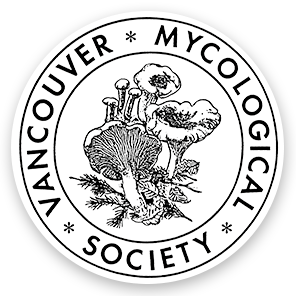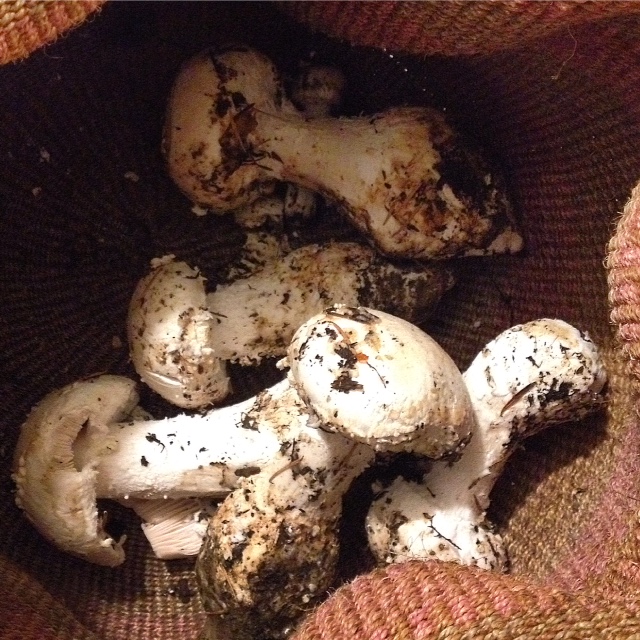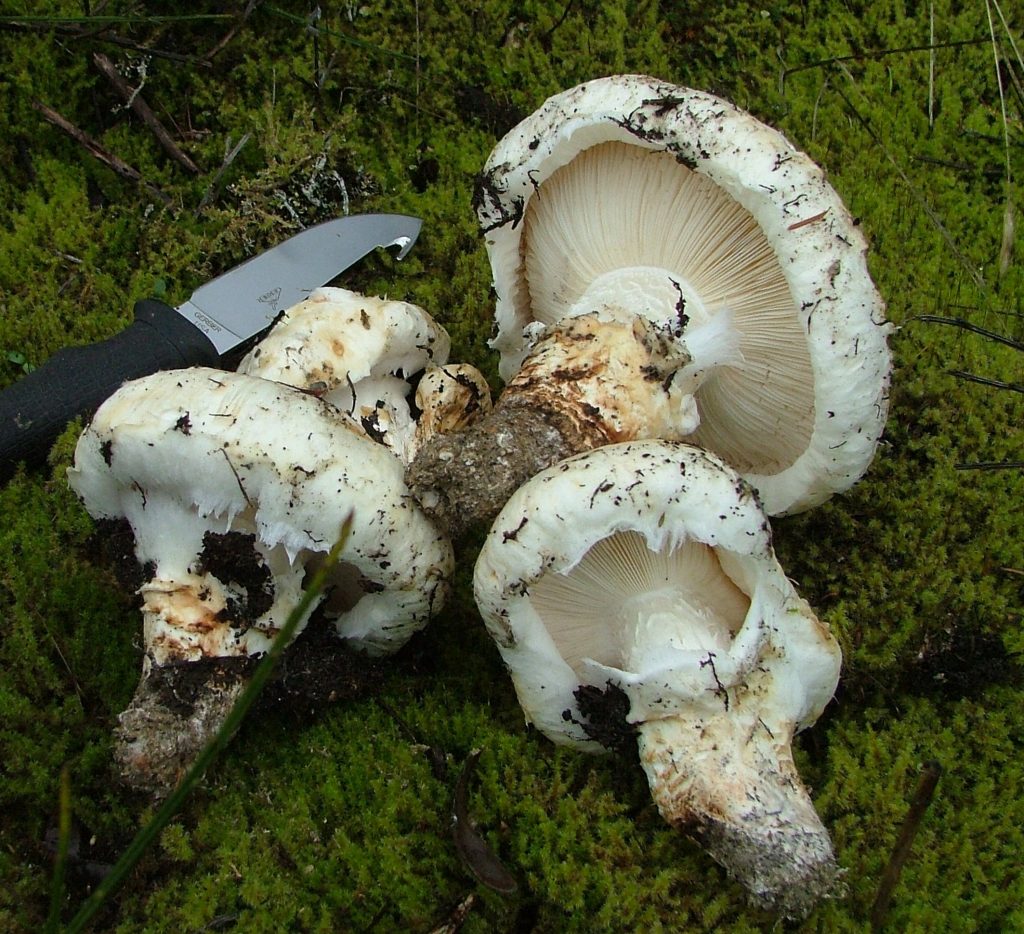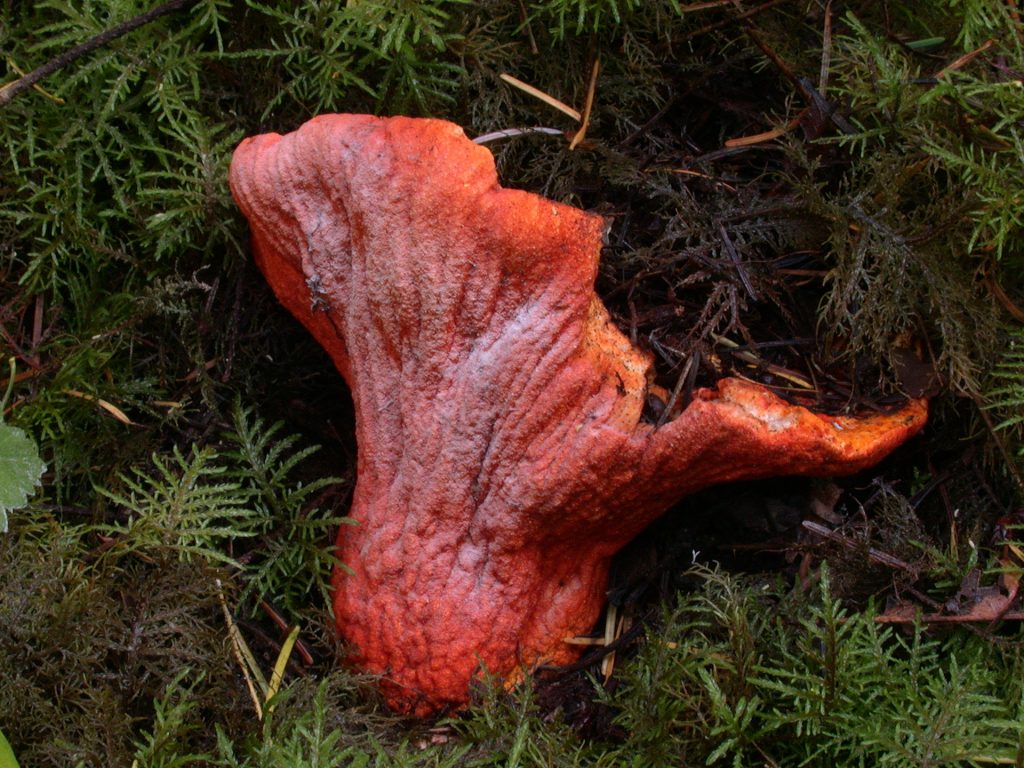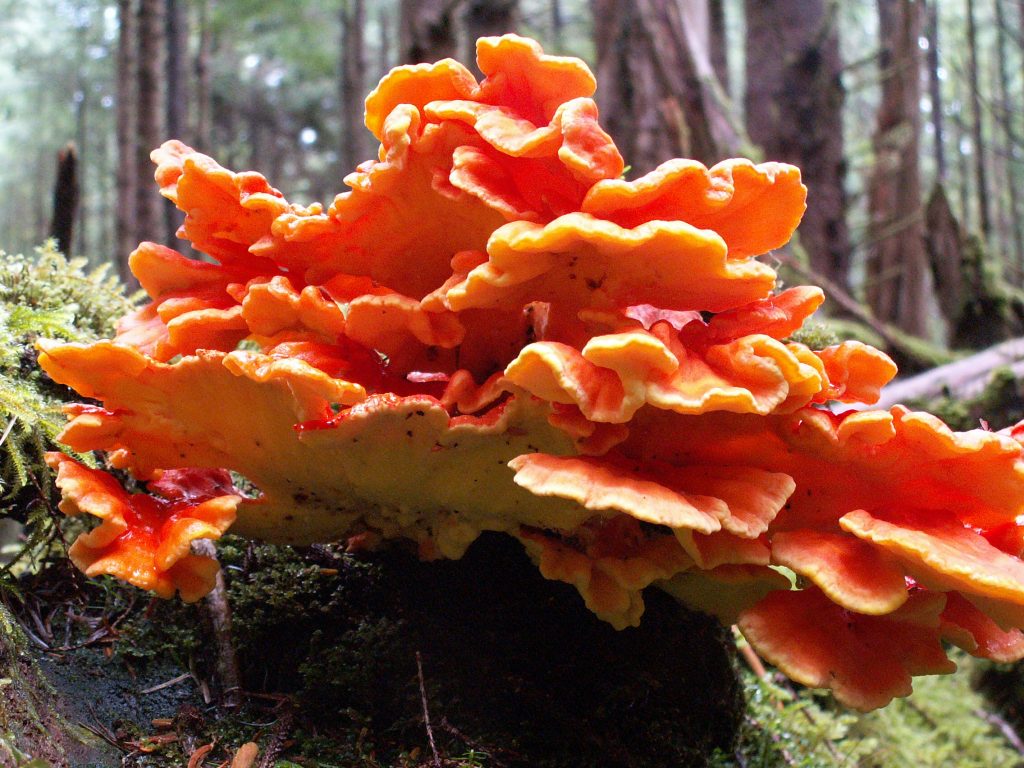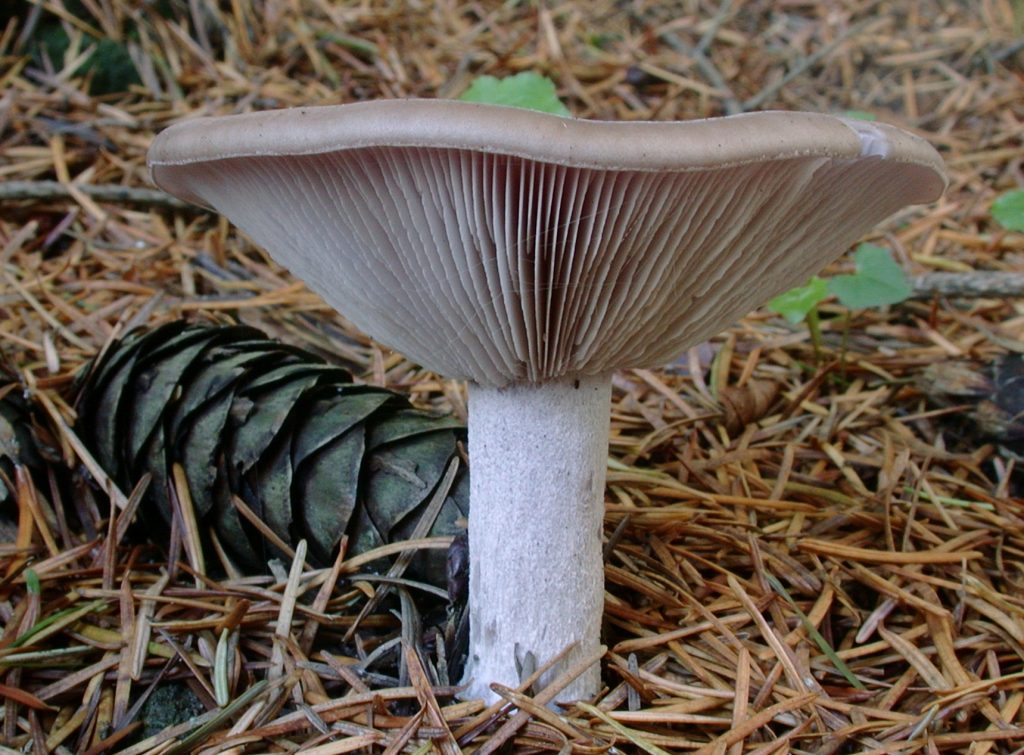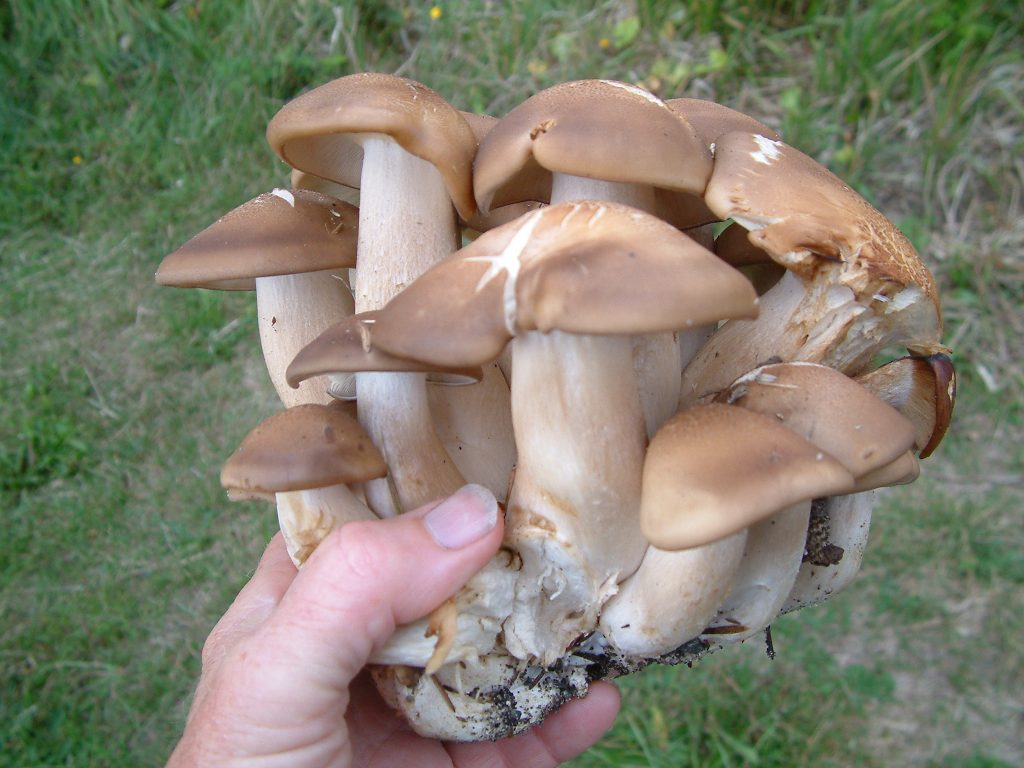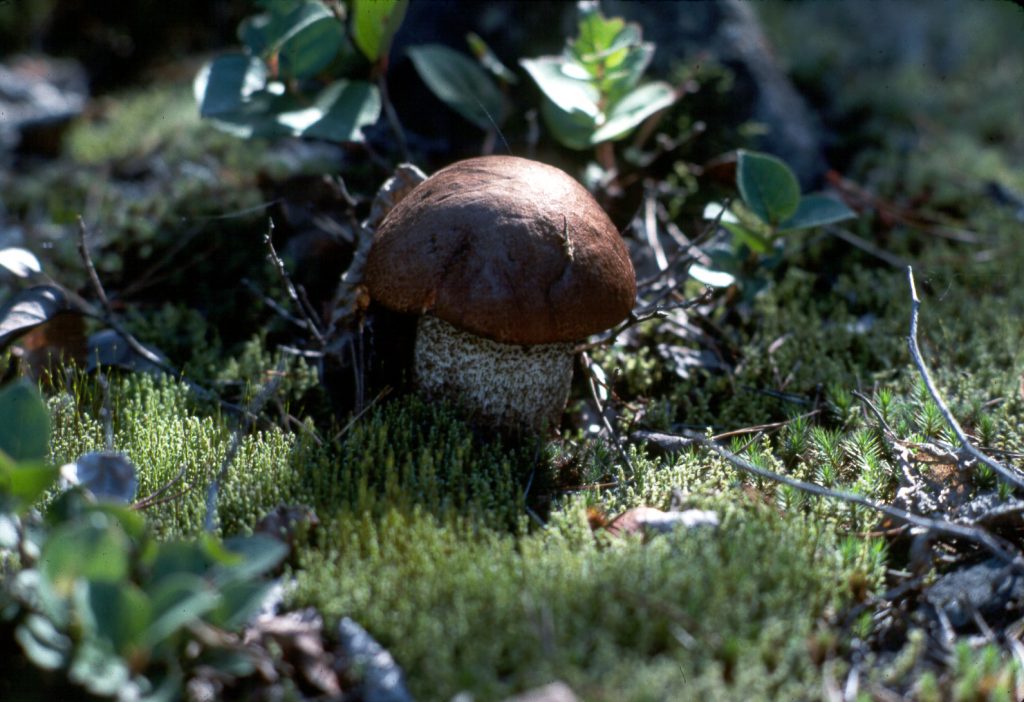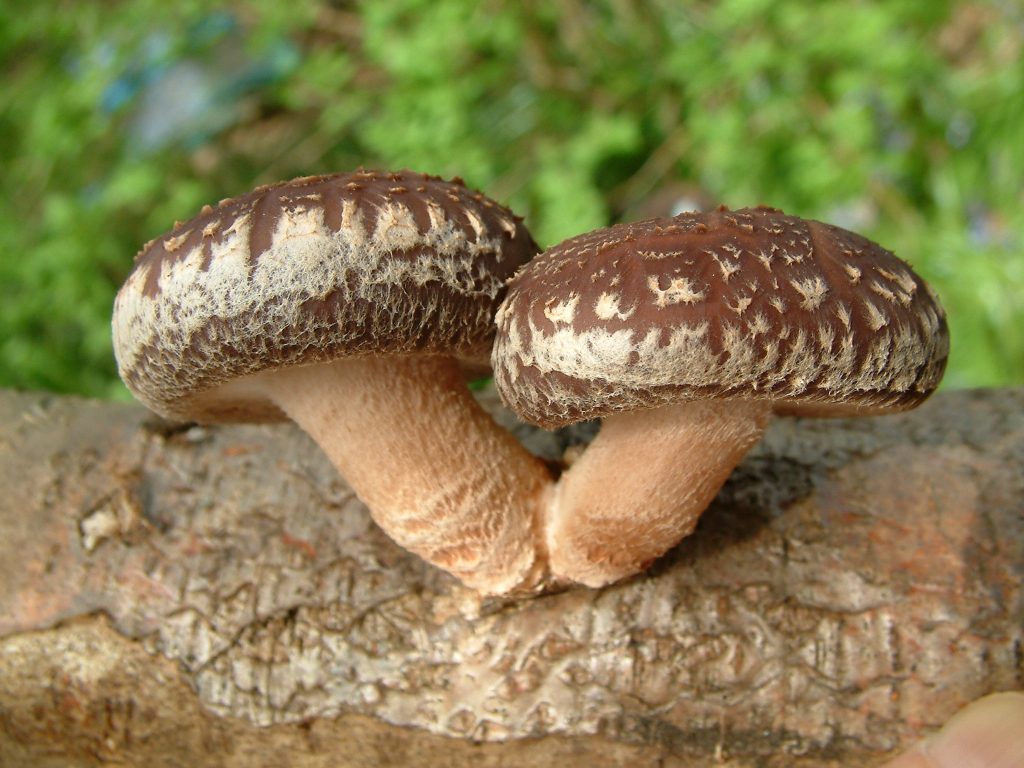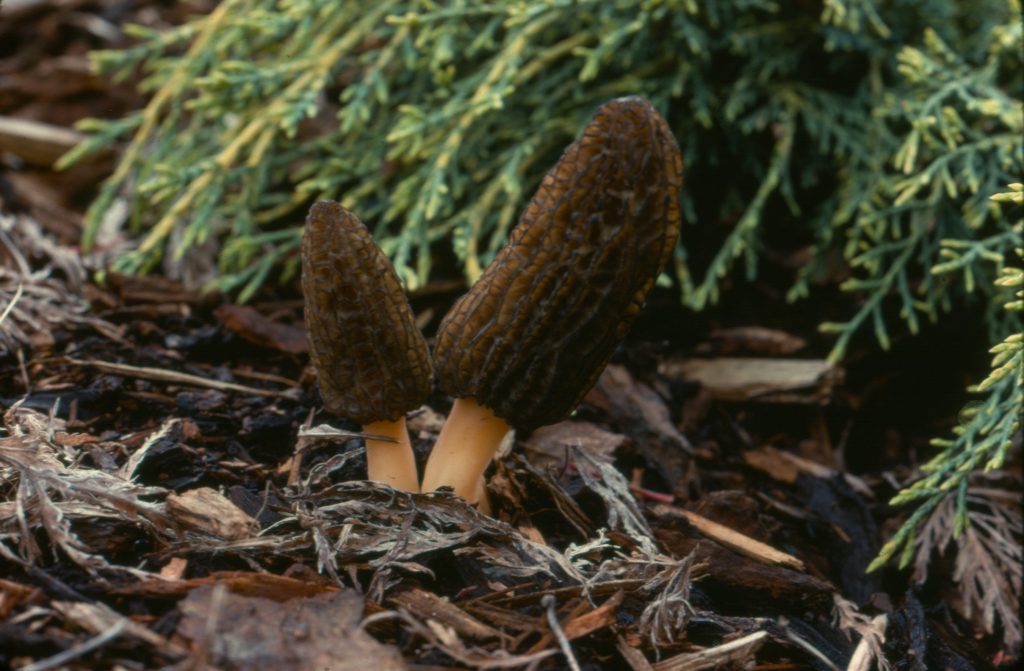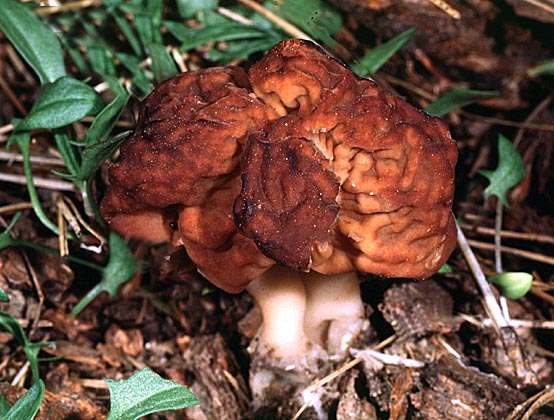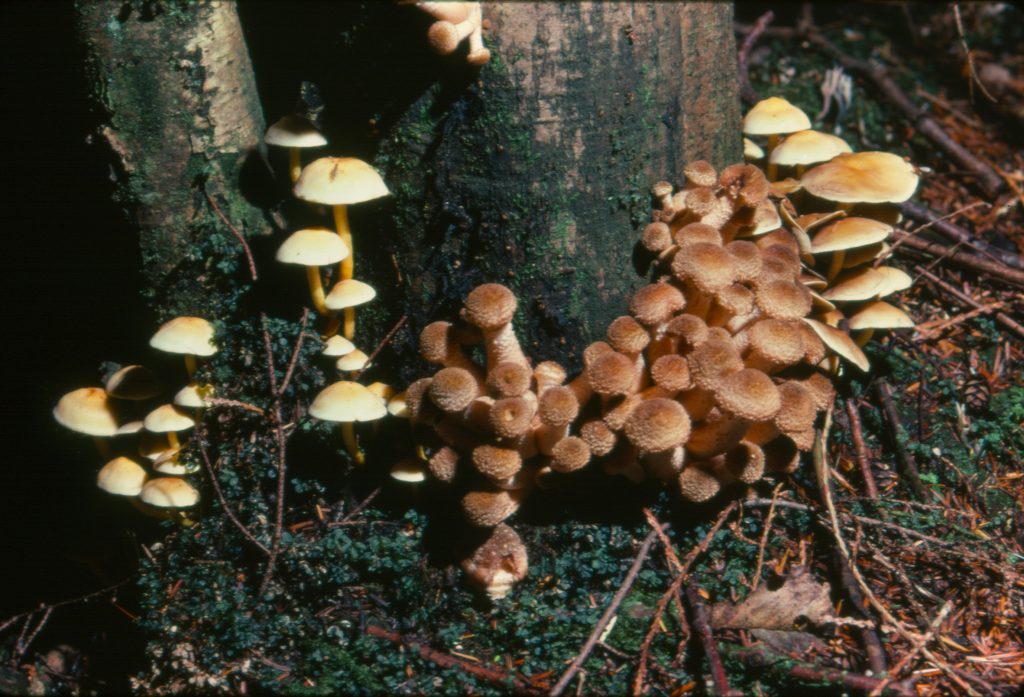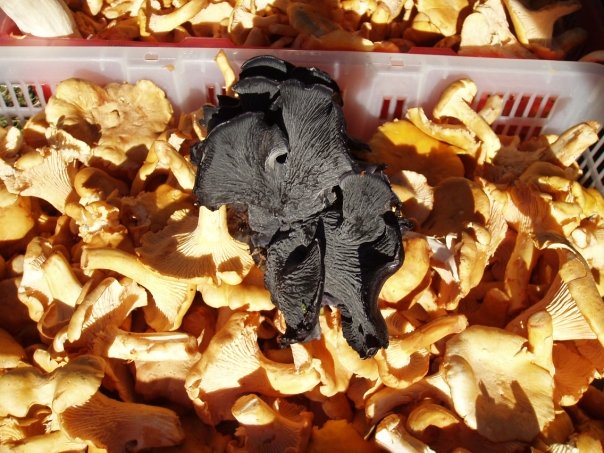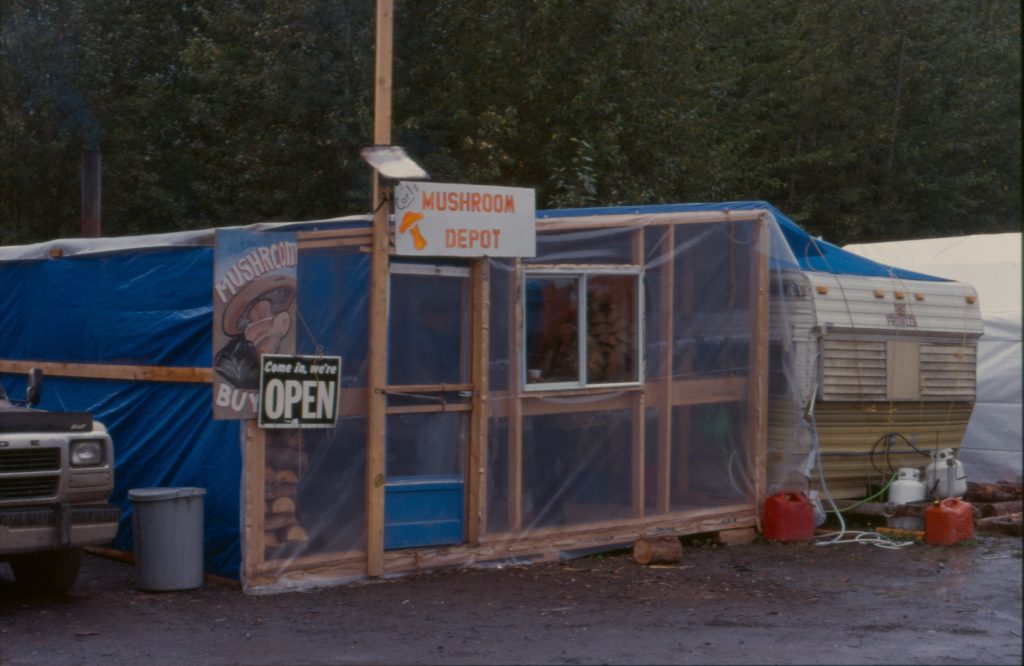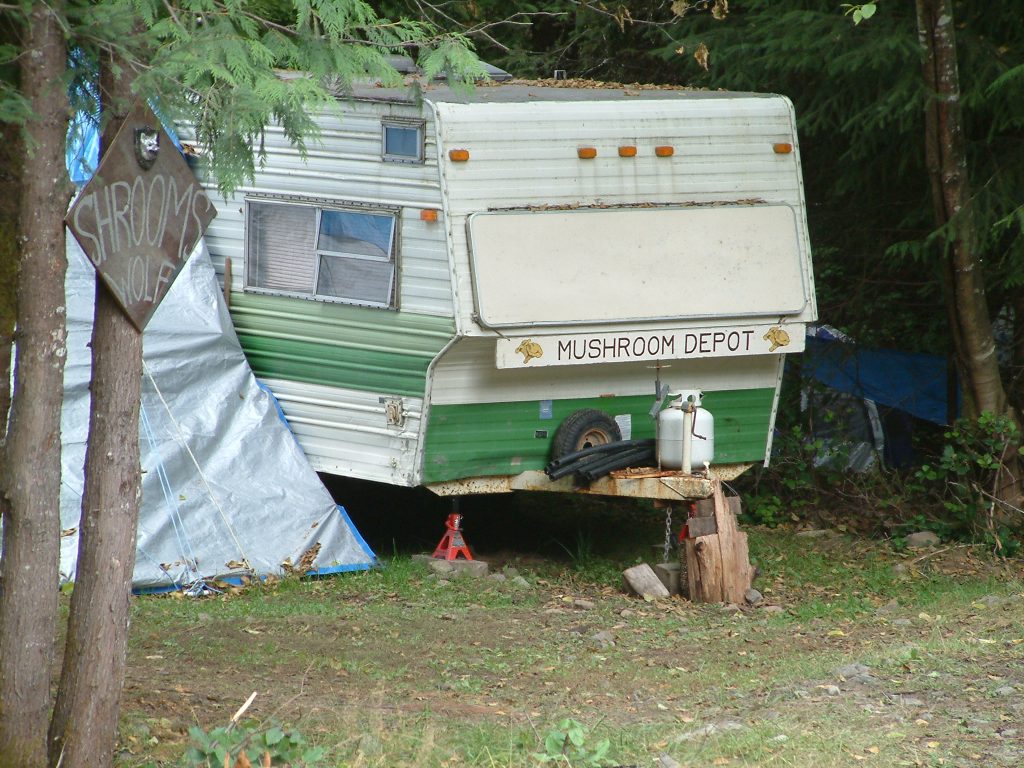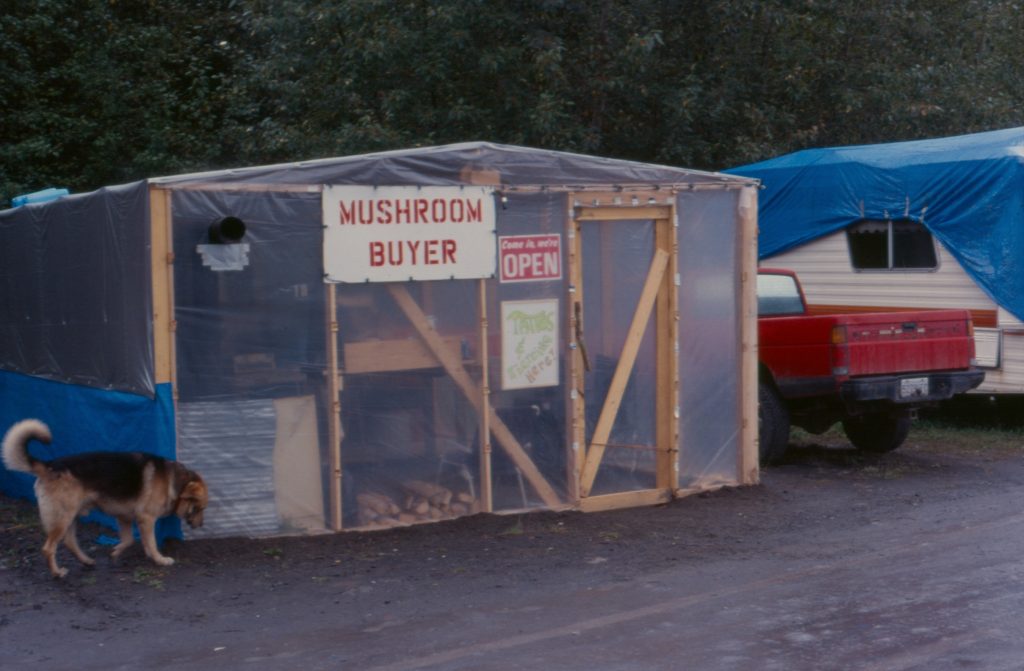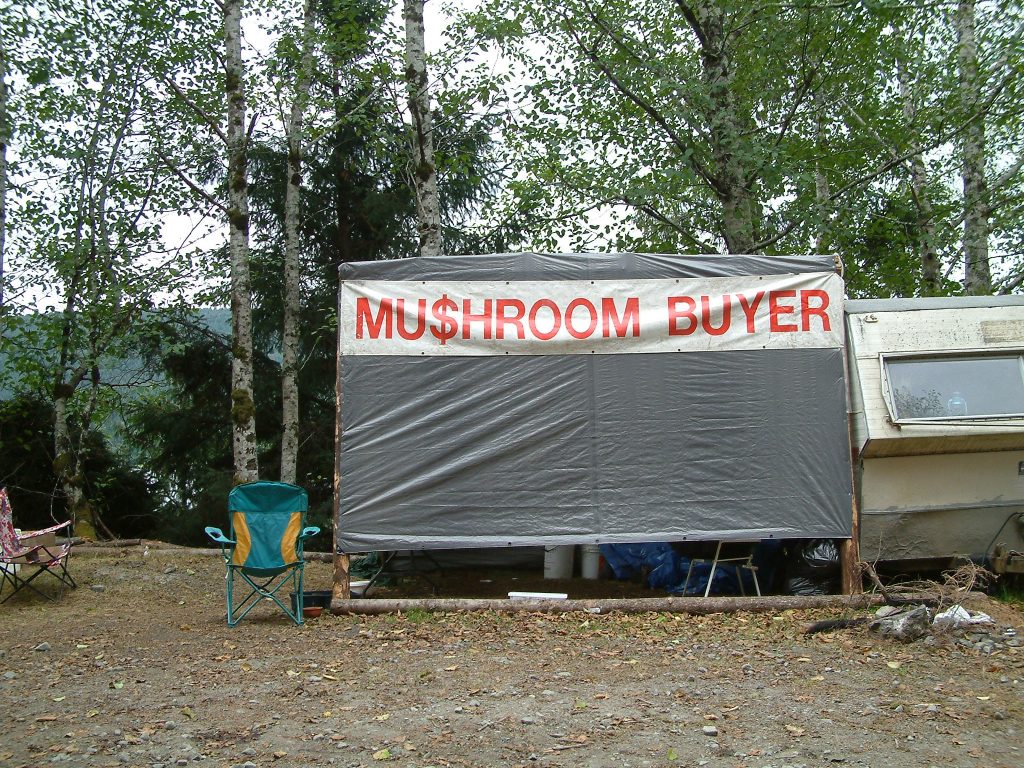By Paul Kroeger
Vancouver Mycological Society (VMS) was formed in 1979 by mushroom enthusiasts who mostly shared a common interest in eating wild fungi. When the society was formed part of its stated purpose was “To assist in educating the public in the collection and identification of fungi, with emphasis on the safe separation of edible from toxic fungi.”
Wild mushrooms have gained great popularity and are commercially collected and sold in an unregulated environment and usually without preparation instructions. Reports of adverse reactions after consuming commercially marketed wild mushrooms are not uncommon. Certain mushrooms that are widely considered edible species appear repeatedly in reports of adverse reactions from mushroom ingestion. See Table 3 p.11: Anomalous edible mushroom poisoning.
Mushroom clubs such as the Vancouver Mycological Society play an important role in informing the public of health hazards associated with eating wild mushrooms and how to avoid them. In this discussion we address some issues surrounding wild mushrooms gathered and distributed as culinary commodities and especially aspects of quality control that effect human health. Similar issues appear in the current “medicinal mushroom” trade but are not addressed here, unless the fungus is also popular for food as well, an example being the Hericium species.
There are a variety of reasons why mushrooms considered edible may cause illness in consumers. Some of these causes and contributing factors are discussed below:
Some species are toxic unless cooked. This is especially relevant with the popular morel mushrooms. In 1991 raw fresh morels were served in a salad at a banquet held in a major Vancouver hotel, and 77 (16%) of the 483 people attending reported illness. Many edible mushrooms contain small amounts of hydrazines and other volatile compounds that are toxic or carcinogenic but are eliminated by cooking, others have heat-sensitive hemolytic proteins.
It should be noted that wild mushrooms offered for sale may have microbial contamination from the environment in which they grow, and from the handling, storage and transportation involved in harvest and marketing. Cooking these mushrooms is thus also an important food hygiene practice.
Over-mature and poorly stored mushrooms may contain micro-organisms of incipient decay and are often implicated in adverse reactions. Many people involved in marketing mushrooms may not recognize signs of aging and decay in unfamiliar species, or may be reluctant to lose profit by discarding aging product.
Mushrooms can grow in habitats that have a history of human disturbance and mushrooms collected in such areas may contain heavy metals or other chemical contaminants from agricultural, industrial, transportation or other human activities. Certain saprobe fungi such as oyster mushrooms are even used in attempts to remediate contaminated sites.
Wild mushrooms are biochemical factories that create and contain very complex and largely unknown chemistry. It is well known, though, that many compounds found in fungi have strong antibiotic effects, and it’s suspected that consuming even well known edible species in excess or when improperly prepared can cause gastrointestinal distress by disrupting a person’s natural intestinal biota.
Improperly preserved wild mushrooms can cause food-borne illness from microbial toxins. Mushrooms are very high risk for home canning because of their neutral pH and close contact with soil microbes such as Botulinum bacteria. Safe canning requires acidification and thorough pressure processing. Other preservation techniques such as brining and storing under oil have also resulted in serious illnesses.
Several wild mushrooms classified as edible in popular guide books are implicated in multiple reports of adverse reactions among consumers. Some incidents involve factors already discussed such as inadequate cooking, over-consumption or microbial contamination; but others don’t and are attributed to individual sensitivities or intolerances that might be present in a significant portion of the population. For this reason certain species could be considered as posing too high a risk to consumer health to be safely marketed as edible mushrooms, examples include all Leccinum species or rough-stemmed boletes, and Phaeolepiota aurea.
Wild mushrooms offered for sale in markets have occasionally been misidentified. For example, there have been sporadic observations of the false morel Gyromitra esculenta being represented as true morels! This is potentially serious because false morels contain toxic hydrazines, compounds responsible for both short term acute poisonings and for chronic effects as known carcinogens.
Itinerant or opportunistic pickers of commercial wild mushrooms may have limited mycological knowledge or experience, and the consumer might have even less familiarity with mushrooms. There are currently no requirements ensuring that marketed wild mushrooms are accurately identified. Certain edible species may require considerable mycological expertise to accurately distinguish from problematic look-alikes and should not be marketed unless identified by an experienced mycologist.
There is currently no means of certifying that wild mushrooms offered for sale are correctly identified by individuals with adequate mycological knowledge and experience. Jurisdictions in many other areas have certification programs for wild mushrooms that require inspection of marketed material by individuals certified as having mushroom identification qualifications.
Sometimes marketed wild mushrooms are referred to only by a common name without the technical or scientific binomial. There is currently no standardized system of common names for mushrooms in North America, so to avoid confusion the technical scientific name is important in identifying and labelling marketed mushrooms. It’s desirable to have a standardized list of approved market mushrooms with standardized common names linked to the scientific binomials.
Some ethical and conservation considerations
Mushroom harvest is prohibited in protected park areas such as National, Provincial Regional and most municipal parks and all Ecological Reserves. Special Management areas and Community forest lands may have restrictions on harvest of non timber forest products (NTFPs) including mushrooms.
Mushrooms growing on First Nations lands are resources belonging to First Nations people. People not of First Nations communities must obtain permission to access those resources.
Certain edible wild mushrooms may become considered “Species at Risk” if declines in their populations or distribution are demonstrated. Continued exploitation of these species would be inappropriate.
Some suggested Guidelines for the commercial wild mushroom market
- Only those species of wild mushrooms known to be safe and tolerated by most people should be sold. A list of approved market species would be desirable with standardized common names linked to scientific binomial names.
- A monitoring or inspection and certification system should be established to ensure that marketed wild mushrooms are wholesome and safe for public consumption. This would ensure the mushroom species is approved as safe for consumption, and that the product is neither decayed nor contaminated.
- To achieve oversight of the commercial wild mushroom industry it will be necessary to have qualified knowledgeable personnel trained to identify approved market mushrooms, possible look-alike species and known poisonous mushrooms. These individuals should also be trained to assess the freshness and suitability for consumption of samples of approved market mushrooms, and to instruct others about identification and quality control of mushrooms.
- Recommended standards of packaging and labelling should be developed for commercial wild mushrooms. Packaging should be appropriate for reducing potentially harmful spoilage and contamination, for example by requiring wrappings to allow air exchange preventing anaerobic conditions. Labels should clearly identify the mushroom or mushrooms contained and advise cooking before consuming.
- Basic information on wild mushroom food safety practices should be made available to those dealing with wild mushrooms where produce is marketed and in the restaurant industry. Guidelines for safe mushroom selection, handling, storage and preparation should be developed and disseminated as printed materials or educational courses.
- The need to cook wild mushrooms before eating should always be clearly communicated to the consumer. “Cook before Eating” labels or stickers are recommended.
- Sellers and vendors of wild mushrooms should be instructed to be diligent in trimming or culling over-aged or deteriorating mushrooms.
It must be pointed out that attempting to impose mandatory regulatory controls over the wild mushroom trade would probably be challenging and possibly resented; harvest and distribution of mushrooms has developed in an informal atmosphere and operates largely as a grey economy.
Harvest and field buying of mushrooms is a seasonal activity which takes place throughout much of BC around small communities where it provides an irregular but often important source of income for rural populations.
Below are listed some British Columbia mushrooms considered to be good edibles and which are candidates for approved status for commercial trade. Many of these species may make their way to farmers’ market stalls, produce stores or restaurants.
Please note that while some are considered choice and safe for most of us to eat, others can cause problems for certain people or if not properly prepared. These problematic species are indicated with an asterisk* and three types, Chickens of the woods (2 species of Laetiporus) and Lobster mushrooms (Hypomyces lactifluorum), are especially problematic. The Laetiporus were excluded because they have failed to achieve popularity, but Lobster mushrooms are retained because they have.
All wild mushrooms should be cooked before eating.
Table 1: List of potential market wild mushrooms for British Columbia
|
1) Boletus edulis group |
Good market mushroom |
Suitable for dried product, seem under-utilized in BC. |
|
2) Boletus fibrillosus |
Good market mushroom |
Suitable for dried product, seem under-utilized in BC. |
|
3) Boletus mirabilis |
Good market mushroom |
Suitable for dried product, seem under-utilized in BC. |
|
4) Boletus rex-veris |
Good market mushroom |
Suitable for dried product, seem under-utilized in BC. |
|
5) Boletus zelleri |
Good market mushroom |
Suitable for dried product, seem under-utilized in BC. |
|
6) Cantharellus cascadensis |
Good market mushroom |
Important commercial mushroom, mostly fresh market. |
|
7) Cantharellus formosus |
Good market mushroom |
Important commercial mushroom, mostly fresh market. |
|
8) Cantharellus roseocanus |
Good market mushroom |
Important commercial mushroom, mostly fresh market. |
|
9) Cantherellus subalbidus |
Good market mushroom |
Important commercial mushroom, mostly fresh market. |
|
10) Craterellus cornucopioides |
Good market mushroom |
Rare in BC. Suitable as dried product. |
|
11) Craterellus tubaeformis |
Good market mushroom |
Seems under-utilized in BC. Potential important commercial mushroom |
|
12) Gomphus clavatus |
Good market mushroom |
Considered endangered in many parts of Europe, extinct in Britain. |
|
13) Grifola frondusus |
Good market mushroom |
Important commercial mushroom, rare in BC |
|
14) Hericium abietis |
Good market mushroom |
Important commercial mushroom, increasing in value and of medicinal interest. |
|
15) Hericium americanus |
Good market mushroom |
Important commercial mushroom, increasing in value and of medicinal interest. |
|
16) Hericium coralloides |
Good market mushroom |
Important commercial mushroom, increasing in value and of medicinal interest. |
|
17) Hericium erinaceus |
Good market mushroom |
Important commercial mushroom, increasing in value and of medicinal interest. Rare in BC. |
|
18) Hydnum repandum |
Good market mushroom |
Important commercial mushroom |
|
19) Hydnum umbilicatum |
Good market mushroom |
Important commercial mushroom |
|
20) Hypomyces lactifluorum * |
problematic |
Important commercial species. Quality control issues exist. Causes occasional GI upset. |
|
21) Imleria badius |
Good market mushroom |
Suitable for dried product |
|
22) Lactarius deliciosus |
Good market mushroom |
Little known here. |
|
23) Lactarius deterrimus |
Good market mushroom |
Little known here. |
|
24) Lactarius rubrilacteus |
Good market mushroom |
Little known here. |
|
25) Lepista nuda |
Little known |
Identification problems, tolerances unknown. Can grow in contaminated environments. |
|
26) Lyophyllum decastes |
Little known |
Identification challenging, tolerances unknown. Can grow in contaminated environments. |
|
27) Morchella spp. * |
problematic |
Important commercial mushroom, especially suitable for dried product. Fresh should have “cook before eating” label. Can grow in contaminated environments. |
|
28) Pleurotus ostreatus |
problematic |
Competes with cultivated Oyster mushrooms. Wild have quality issues and can grow in contaminated environments. |
|
29) Polyozellus atrolazulinus |
Good market mushroom |
Was Polyozellus multiplex. Conservation status of concern, uncertain due to lack of distribution data. |
|
30) Polyozellus marymargaretae |
Good market mushroom |
Was Polyozellus multiplex. Conservation status of concern, uncertain due to lack of distribution data. |
|
31) Rozites caperata |
Little known |
Identification problems, tolerances unknown |
|
32) Russula xerampelina |
Little known |
Identification issues, tolerances unknown |
|
33) Sparassis crispa |
Good market mushroom |
Cauliflower mushroom, highly desirable but not well known as market mushroom. |
|
34) Suillus borealis |
Little known |
Suitable for dried product |
|
35) Suillus brevipes |
Little known |
Suitable for dried product |
|
36) Suillus granulatus |
Little known |
Suitable for dried product |
|
37) Suillus lakei |
Little known |
Suitable for dried product |
|
38) Suillus luteus |
Little known |
Suitable for dried product |
|
39) Suillus species |
Little known |
Suitable for dried product |
|
40) Suillus subolivaceus |
Little known |
Suitable for dried product |
|
41) Tricholoma magnivelare |
Good market mushroom |
Important commercial mushroom. High value almost all fresh market, much exported. |
|
42) Tuber gibbosum |
Good market mushroom |
Important commercial mushroom |
How mushroom species were selected as potential market mushrooms
The mushrooms in the preceding list were selected from a larger list of mushrooms, see Table 2 p.7: Some Edible Wild Mushrooms of British Columbia, which are species classified as edible in popular field guides or reported as being sold in British Columbia. Species were eliminated from this larger list if they present problems in ensuring a potential consumer’s health.
Several of these have been recorded as causing negative reactions in sufficient numbers of people to be considered too high risk for a commercial market. See Table 3 p. 11 Anomalous Edible Mushroom Poisoning for a summary of frequently implicated “Edible” mushrooms.
Several saprobic mushrooms are excluded from the approved listing because they often grow in habitats associated with human disturbance and may present a higher than acceptable possibility of environmental contamination. Most are minor edibles not highly valued. Examples of such wild saprobes are Agaricus, Chlorophyllum and Coprinus. See Table 4 p. 12: Edible mushrooms with common names and life style or trophic mode.
When saprobe mushroom species which might come from contaminated sites are retained on the approved list, it may be desirable to require some documentation of safe provenance. This would apply to such mushrooms as Lepista, Lyophyllum, Morchella and Pleurotus.
Certain edible mushrooms present a challenge for most people to reliably identify and may closely resemble toxic species. Examples of mushrooms that present identification challenges are Agaricus, Armillaria, Chlorophyllum, Clitopilus, Lepista and Lyophyllum.
Table 2: Some Edible Wild Mushrooms of British Columbia
An asterix (*) following the name indicates mushrooms associated with human illness in mushroom poisoning reports. Please see also Table 3 p. 11: Anomalous Edible Mushroom Poisonings.
|
Latin Name |
Market suitability |
Comments |
|
Agaricus augustus |
problematic |
Identification problems, tolerances unknown |
|
Agaricus campestris |
problematic |
Competes with cultivated button mushroom. Quality control issues. |
|
Armillaria species * |
High risk, not suitable |
Identification problems, quality control problems. Causes occasional GI upset. |
|
Boletus edulis group |
Good market mushroom |
Suitable for dried product. Seems under-utilized in BC |
|
Boletus fibrillosus |
Good market mushroom |
Suitable for dried product |
|
Boletus mirabilis |
Good market mushroom |
Suitable for dried product |
|
Boletus rex-veris |
Good market mushroom |
Suitable for dried product |
|
Boletus zelleri |
Good market mushroom |
Suitable for dried product |
|
Cantharellus cascadensis |
Good market mushroom |
Important commercial mushroom |
|
Cantharellus formosus |
Good market mushroom |
Important commercial mushroom |
|
Cantharellus roseocanus |
Good market mushroom |
Important commercial mushroom |
|
Cantherellus subalbidus |
Good market mushroom |
Important commercial mushroom |
|
Catathelasma imperialis |
Little known |
Little known in BC |
|
Chlorophyllum brunneum |
Little known |
Identification problems, tolerances unknown, habitat contamination. |
|
Chlorophyllum olivieri |
Little known |
Identification problems, tolerances unknown, habitat contamination |
|
Chlorophyllum rachodes |
Little known |
Identification problems, tolerances unknown, habitat contamination |
|
Clitopilus prunulus |
Little known |
Identification problems, tolerances unknown, habitat contamination |
|
Coprinus comatus |
problematic |
Not suitable for commercial market. Shipping and storage problems, habitat contamination. |
|
Craterellus cornucopioides |
Good market mushroom |
Rare in BC |
|
Craterellus tubaeformis |
Good market mushroom |
Seems under-utilized in BC. Potential important commercial mushroom |
|
Flammulina velutipes |
Problematic |
May be myotoxic and cardiotoxic . Wild-grown not used as food but it is available in cultivated form. |
|
Gomphus clavatus |
Good market mushroom |
Rare. Considered endangered in many parts of Europe, extinct in Britain. |
|
Grifola frondusus |
Good market mushroom |
Important commercially, rare in BC |
|
Hericium abietis |
Good market mushroom |
Important commercial mushroom |
|
Hericium americanus |
Good market mushroom |
Important commercial mushroom |
|
Hericium coralloides |
Good market mushroom |
Important commercial mushroom |
|
Hericium erinaceus |
Good market mushroom |
Important commercial mushroom. Rare in BC |
|
Hydnum repandum |
Good market mushroom |
Important commercial mushroom |
|
Hydnum umbilicatum |
Good market mushroom |
Important commercial mushroom |
|
Hypomyces lactifluorum * |
Problematic |
Important commercial species. Quality control issues. Causes occasional GI upset. |
|
Imleria badius |
Good market mushroom |
Suitable for dried product |
|
Lactarius deliciosus |
Good market mushroom |
Little known in BC |
|
Lactarius deterrimus |
Good market mushroom |
Little known in BC |
|
Lactarius rubrilacteus |
Good market mushroom |
Little known in BC |
|
Laetiporus conifericola * |
High risk, not suitable |
Quality control problems. Causes occasional GI upset. Only youngest growth stage is safe and desirable. Was called L. sulphureus |
|
Laetiporus gilbertsonii * |
High risk, not suitable |
Quality control problems. Causes occasional GI upset. Only youngest growth stage is safe and desirable. Was called L. sulphureus |
|
Leccinum aurantiacum * |
High risk, not suitable |
Causes occasional GI upset. |
|
Leccinum scabrum* |
High risk, not suitable |
Causes occasional GI upset. |
|
Leccinum species * |
High risk, not suitable |
Cause occasional GI upset. |
|
Lepista nuda |
Little known |
Identification problems, tolerances unknown, habitat contamination. |
|
Lepista praemagna |
Little known |
Little known in BC, traditional use. |
|
Lyophyllum decastes |
Little known |
Identification problems, tolerances unknown, habitat contamination. |
|
Morchella spp. * |
problematic |
Important commercial mushroom especially suitable for dried product. Toxic raw, habitat contamination and quality control issues. |
|
Phaeolepiota aurea* |
High risk, not suitable |
Causes frequent GI upset, habitat contamination. |
|
Pleurocybella porrigens * |
High risk, not suitable |
Caused fatalities in Japan. |
|
Pleurotus ostreatus |
problematic |
Competes with cultivated Oyster mushrooms. |
|
Pluteus cervinus |
Little known |
Identification issues, not desirable. |
|
Polyozellus atrolazulinus |
Good market mushroom |
Was Polyozellus multiplex. Conservation status of concern, uncertain due to lack of distribution data. |
|
Polyozellus marymargaretae |
Good market mushroom |
Was Polyozellus multiplex. Conservation status of concern, uncertain due to lack of distribution data. |
|
Rozites caperata |
Little known |
Identification problems, tolerances unknown |
|
Russula xerampelina |
Little known |
Identification issues, tolerances unknown |
|
Sarcodon imbricatus |
Little known |
Identification issues, not desirable. |
|
Sparassis crispa |
Good market mushroom |
|
|
Suillus borealis |
Little known |
Suitable for dried product |
|
Suillus brevipes |
Little known |
Suitable for dried product |
|
Suillus granulatus |
Little known |
Suitable for dried product |
|
Suillus lakei |
Little known |
Suitable for dried product |
|
Suillus luteus |
Little known |
Suitable for dried product |
|
Suillus species |
Little known |
Suitable for dried product |
|
Suillus subolivaceus |
Little known |
Suitable for dried product |
|
Tricholoma flavovirens* or Tricholoma equestre* |
High risk, not suitable |
Caused fatalities in France |
|
Tricholoma magnivelare |
Good market mushroom |
Important commercial mushroom |
|
Tricholoma populinum |
Little known |
Little known in BC, traditional use. |
|
Tuber gibbosum |
Good market mushroom |
Important commercial mushroom |
|
Verpa bohemica |
High risk, not suitable |
|
Wild mushroom species that may be considered too high risk to be marketed Commercially or that may need special standards or labelling
Armillaria species, Honey mushrooms: Frequently implicated with problems if over-mature and/or under-cooked. Accurate identification is critical because some dangerous mushrooms have similar growth habit and occur in the same habitat. These should be considered as high risk of causing illness.
Hypomyces lactifluorum, Lobster mushroom: Frequently implicated with problems if over-mature and/or under-cooked or with excessive or repeated consumption. Individual intolerance is apparent in some people. This is already a well established market mushroom sold fresh and dried. Lobster mushrooms sold fresh should have labels directing they be cooked before eating.
Laetiporus species, Chickens of the woods: Usually marketed when over-mature and tough and unpalatable. Frequently causes gastrointestinal distress especially if undercooked. Only the very youngest and softest parts are edible and desirable. These should be considered as high risk of causing illness.
Leccinum species, rough stemmed boletes: Many cases of gastrointestinal upset are reported for various species. Individual intolerance may be common. The entire genus should be considered high risk of causing illness especially when fresh.
Morchella species sold fresh should have labels directing they be cooked before eating.
Phaeolepiota aurea, Gold-cap: Individual intolerance is frequent. These should be considered as high risk of causing illness.
Pleurocybella porrigens, Angel wings: This species was implicated in fatal poisonings in Japan. These should be considered as high risk of causing illness.
Tricholoma equestre or Tricholoma flavovirens, Man on horseback: In France these were implicated in fatal poisonings. These should be considered as high risk of causing illness.
Edible BC mushroom species that may have sustainability and conservation concerns
Craterellus cornucopioides is known only from a small area on southern Vancouver Island. Imported material apparently from California and Oregon appears in our markets at times.
Gomphus clavatus seems rare in BC and has been red-listed in many parts of Europe due to decline or extirpation. An old-growth associated mushroom.
Grifola frondusus is only known in BC from Vancouver, Victoria and Greenwood in the Boundary district.
Hericium erinaceus is only known from the Salish Sea and southern Vancouver Island on Garry oak and broadleaf maple.
Polyozellus atrolazulinus and Polyozellus marymargaretae are recently recognized old-growth associated species with unknown distribution and range. Previously both were known as Polyozellus multiplex considered rather uncommon and locally abundant in only very few areas.
Table 3: Anomalous Edible Mushroom Poisoning
|
Mushroom involved Type of syndrome |
Time of onset and notes |
Symptoms |
|
Armillaria species
Gastrointestinal upset |
1 hour to 5 hours Raw or undercooked or when over-mature. |
Nausea, vomiting and diarrhea. |
|
Hypomyces lactifluorum
Gastrointestinal upset |
30 minutes to several hours. Undercooked or overmature |
Severe gastrointestinal distress, cramping, disoriented, sweating, weak. |
|
Laetiporus sulphureus and Laetiporus conifericola
Gastrointestinal upset, neurotoxic |
Gastrointestinal 5 to 45 minutes. Undercooked or overmature. Neurotoxic about one hour after eating raw, in child. |
Causes nausea, vomiting, dizziness, abdominal pain, headache and fatigue, tingling of extremities. Also disorientation, ataxia, hallucinations in child. |
|
Leccinum species
Gastrointestinal upset
|
1 to 5 hours May cause upset even if well cooked, exact species involved often unknown. |
Diarrhea, nausea and vomiting, sweating and dry mouth, malaise, headache and dizziness. |
|
Lentinula edodes
Skin rash and gastrointestinal upset |
20 minutes to several hours Fresh cultivated mushrooms eaten raw or undercooked |
Flagellate erythema (hives-like rash in streaks), Gastrointestinal upset, chills, disoriented, headache, muscle spasms, unconscious, weak, difficulty breathing |
|
Morchella species
Gastrointestinal upset |
5 to 45 minutes Toxic when eaten raw, alcohol consumed may also cause problems. |
Nausea, vomiting and abdominal pain and cramping. |
|
Phaeolepiota aurea Gastrointestinal upset |
30 minutes to 2 hours Intolerance in certain individuals is common |
Gastrointestinal upset with severe nausea. |
|
Pleurocybella porrigens Encephalopathy: Deaths reported in Japan |
2 to 3 weeks Patients all older males with kidney disease, most had received dialysis prior to ingestion. |
Tremor, weakness of extremities, disturbance of consciousness, intractable seizures; cerebral cortex lesions. |
|
Tricholoma equestre or flavovirens Rhabdomyolysis: Deaths reported in France |
1 to 4 days following repeated meals (3 or more) over two weeks or more. |
Fatigue, muscle weakness and pain, anorexia, nausea, profuse sweating, myogloburia; kidney failure. |
Table 4: Some edible mushrooms with common names and life style or trophic mode
|
Latin Name |
Common Names |
Comments |
|
Agaricus augustus |
The Prince |
Saprotroph |
|
Agaricus campestris |
Meadow mushroom |
Saprotroph |
|
Armillaria species * |
Honey mushrooms * |
Wood decay |
|
Boletus edulis group |
King bolete, Cep, Porcini |
Ectomycorrhizal |
|
Boletus fibrillosus |
Dark king bolete |
Ectomycorrhizal |
|
Boletus mirabilis |
Admirable Bolete |
Ectomycorrhizal |
|
Boletus rex-veris |
Spring king bolete |
Ectomycorrhizal |
|
Boletus zelleri |
Zeller’s bolete |
Ectomycorrhizal |
|
Cantharellus cascadensis |
Cascade chamterelle |
Ectomycorrhizal |
|
Cantharellus formosus |
Golden Chanterelle |
Ectomycorrhizal |
|
Cantharellus roseocanus |
Rainbow Chanterelle |
Ectomycorrhizal |
|
Cantherellus subalbidus |
White chanterelle |
Ectomycorrhizal |
|
Catathelasma imperialis |
Giant Cat |
Ectomycorrhizal |
|
Chlorophyllum brunneum |
Shaggy parasol |
Saprotroph |
|
Chlorophyllum olivieri |
Shaggy parasol |
Saprotroph |
|
Chlorophyllum rachodes |
Shaggy parasol |
Saprotroph |
|
Clitopilus prunulus |
Sweetbread mushroom |
Saprotroph |
|
Coprinus comatus |
Shaggy Mane |
Saprotroph |
|
Craterellus cornucopioides |
Black chanterelle |
Ectomycorrhizal |
|
Craterellus tubaeformis |
Winter Chanterelle, Yellow Foot |
Ectomycorrhizal |
|
Flammulina velutipes |
Enoke, Enoketake |
Wood decay |
|
Gomphus clavatus |
Pig’s ear gomphus |
Ectomycorrhizal |
|
Grifola frondusus |
Maitake |
Wood decay |
|
Hericium abietis |
Bear’s Head or Lion’s Mane |
Wood decay |
|
Hericium americanus |
Bear’s Head or Lion’s Mane |
Wood decay |
|
Hericium coralloides |
Bear’s Head or Lion’s Mane |
Wood decay |
|
Hericium erinaceus |
Bear’s Head or Lion’s Mane |
Wood decay |
|
Hydnum repandum |
Hedgehog, Sweet Tooth |
Ectomycorrhizal |
|
Hydnum umbilicatum |
Belly-button Hedgehog |
Ectomycorrhizal |
|
Hypomyces lactifluorum * |
Lobster mushroom * |
Parasite on Russula |
|
Lactarius deliciosus |
Orange Milkcap |
Ectomycorrhizal |
|
Lactarius deterrimus |
Spruce Orange Milkcap |
Ectomycorrhizal |
|
Laetiporus conifericola * |
Chicken of the Woods * |
Wood decay |
|
Laetiporus gilbertsonii * |
Chicken of the Woods * |
Wood decay |
|
Leccinum aurantiacum * |
Orange Cap bolete * |
Ectomycorrhizal |
|
Leccinum scabrum* |
Birch bolete* |
Ectomycorrhizal |
|
Leccinum species * |
Rough stem boletes * |
Ectomycorrhizal |
|
Lepista nuda |
Blewit |
Saprotroph |
|
Lepista praemagna |
Giant blewit |
Saprotroph |
|
Lyophyllum decastes |
Fried Chicken mushroom |
Saprotroph |
|
Morchella spp. * |
Morels * |
Saprotroph |
|
Phaeolepiota aurea* |
Gold-cap* |
Saprotroph |
|
Pleurocybella porrigens * |
Angels’ Wings * |
Wood decay |
|
Pleurotus ostreatus |
Oyster mushroom |
Wood decay |
|
Pluteus cervinus |
Deer mushroom |
Wood decay |
|
Polyozellus atrolazulinus |
Blue or Purple Chanterelle |
Ectomycorrhizal |
|
Polyozellus marymargaretae |
Blue or Purple Chanterelle |
Ectomycorrhizal |
|
Rozites caperata |
Gypsy mushroom |
Ectomycorrhizal |
|
Russula xerampelina |
Shrimp mushroom |
Ectomycorrhizal |
|
Sarcodon imbricatus |
Hawk’s wing, scaly hedgehog |
Ectomycorrhizal |
|
Sparassis crispa |
Cauliflower mushroom |
Root parasite? |
|
Suillus brevipes |
Short-stemmed slippery jack |
Ectomycorrhizal |
|
Suillus granulatus |
Granulated slippery jack |
Ectomycorrhizal |
|
Suillus lakei |
Lake’s bolete |
Ectomycorrhizal |
|
Suillus luteus |
Slippery jack |
Ectomycorrhizal |
|
Suillus subolivaceus |
Slippery Jill |
Ectomycorrhizal |
|
Tricholoma flavovirens * |
Man on Horseback * |
Ectomycorrhizal |
|
Tricholoma magnivelare |
Pine mushroom, Matsutake |
Ectomycorrhizal |
|
Tricholoma populinum |
Big sandy |
Ectomycorrhizal |
|
Tuber gibbosum |
Oregon white truffle |
Ectomycorrhizal |
|
Verpa bohemica |
Early morel |
Ectomycorrhizal |
Table 5: Scientific names of BC’s edible mushrooms
Here are current names for BC edible fungi, from Kroeger & Berch 2017 with some additions. Names conform to Index Fungorum. Scientific names for fungi are rapidly changing as genetic studies reveal how different species are related or not. Many mushrooms we knew by familiar European names are being recognized as new species native to this region.
|
Mushroom name and authority |
Family |
comments |
|
Agaricus arvensis Schaeff. |
Agaricaceae |
|
|
Agaricus augustus Fr. |
Agaricaceae |
|
|
Agaricus bernardii Quel. |
Agaricaceae |
|
|
Agaricus bisporus (J.E. Lange) Imbach |
Agaricaceae |
|
|
Agaricus bitorquis (Quel.) Sacc. |
Agaricaceae |
|
|
Agaricus campestris Fr. |
Agaricaceae |
|
|
Agaricus subrufescens Peck |
Agaricaceae |
|
|
Agaricus subrutilescens (Kauffman) Hotson & D.E. Stuntz |
Agaricaceae |
|
|
Agaricus sylvaticus Schaeff. |
Agaricaceae |
also as A.haemorrhoidarius |
|
Agaricus sylvicola (Vittad.) Peck |
Agaricaceae |
as Agaricus silvicola |
|
Armillaria cepistipes Velen. |
Physalacriaceae |
|
|
Armillaria gallica Marxm. & Romagn. |
Physalacriaceae |
|
|
Armillaria gemina Berube & Dessur. |
Physalacriaceae |
|
|
Armillaria mellea (Vahl) P. Kumm. |
Physalacriaceae |
|
|
Armillaria nabsnona T.J. Volk & Burds. |
Physalacriaceae |
|
|
Armillaria ostoyae (Romagn.) Herink |
Physalacriaceae |
|
|
Armillaria sinapina Bérubé & Dessur. |
Physalacriaceae |
|
|
Armillaria solidipes Peck |
Physalacriaceae |
|
|
Aureoboletus flaviporus (Earle) Klofac |
Boletaceae |
as Boletus |
|
Aureoboletus mirabilis (Murrill) Halling |
Boletaceae |
as Boletus |
|
Boletus aereus Bull. |
Boletaceae |
|
|
Boletus barrowsii Thiers & A.H. Sm. |
Boletaceae |
|
|
Boletus coniferarum Lebedeva |
Boletaceae |
|
|
Boletus edulis Bull. |
Boletaceae |
|
|
Boletus erythropus Pers. |
Boletaceae |
|
|
Boletus ferrugineus Schaeff. |
Boletaceae |
Boletus spadiceus Schaeff. |
|
Boletus fibrillosus Thiers |
Boletaceae |
|
|
Boletus regineus Arora & Simonini |
Boletaceae |
|
|
Boletus rubriceps D. Arora & J.L.Frank |
Boletaceae |
|
|
Boletus smithii Thiers |
Boletaceae |
|
|
Boletus subtomentosus L. |
Boletaceae |
|
|
Butyriboletus appendiculatus (Schaeff.) D. Arora & J.L. Frank |
Boletaceae |
as Boletus |
|
Cantharellus californicus Arora & Dunham |
Cantharellaceae |
|
|
Cantharellus cascadensis J.S. Dunham, O’Dell & R. Molina |
Cantharellaceae |
|
|
Cantharellus cibarius Fr. |
Cantharellaceae |
|
|
Cantharellus formosus Corner |
Cantharellaceae |
|
|
Cantharellus pallens Pilat |
Cantharellaceae |
IF Cantharellus cibarius var. pallens |
|
Cantharellus roseocanus (Redhead, Norvell & Danell) Redhead, Norvell & Moncalvo |
Cantharellaceae |
|
|
Cantharellus subalbidus A.H. Sm. & Morse |
Cantharellaceae |
|
|
Catathelasma imperiale (Quél.) Singer |
Tricholomataceae |
|
|
Catathelasma ventricosum (Peck) Singer |
Tricholomataceae |
|
|
Chlorophyllum brunneum (Farl. & Burt) Vellinga |
Agaricaceae |
also as Lepiota |
|
Chlorophyllum olivieri (Barla) Vellinga |
Agaricaceae |
|
|
Chlorophyllum rachodes (Vittad.) Vellinga |
Agaricaceae |
also as Lepiota, as Macrolepiota rhacodes |
|
Clitocybe praemagna (Murrill) H.E. Bigelow & A.H. Sm. |
Tricholomataceae |
As Lepista |
|
Clitopilus prunulus (Scop.) P. Kumm. |
Entolomataceae |
|
|
Coprinus comatus (O.F. Müll.) Pers. |
Agaricaceae |
|
|
Cortinarius caperatus (Pers.) Fr. |
Cortinariaceae |
as Rozites caperata |
|
Craterellus cornucopioides (L.) Pers. |
Cantharellaceae |
|
|
Craterellus tubaeformis (Fr.) Quél. |
Cantharellaceae |
as Cantharellus tubaeformis, C.infundibuliformis |
|
Flammulina populicola Redhead & R.H. Petersen |
Physalacriaceae |
as F. velutipes |
|
Flammulina velutipes (Curtis) Singer |
Physalacriaceae |
|
|
Gomphus clavatus (Pers.) Gray |
Gomphaceae |
as Cantharellus clavatus |
|
Grifola frondosa (Dicks.: Fr.) Gray |
Meripilaceae |
|
|
Hericium abietis (Weir ex Hubert) K.A. Harrison |
Hericiaceae |
|
|
Hericium americanum Ginns |
Hericiaceae |
|
|
Hericium coralloides (Scop.) Pers. |
Hericiaceae |
also as Hericium ramosum |
|
Hericium erinaceus (Bull.) Pers. |
Hericiaceae |
|
|
Hydnum ellipsosporum Ostrow & Beenken |
Hydnaceae |
as Hydnum sp. F19678 |
|
Hydnum indurescens D. Hall & D.E. Stuntz |
Hydnaceae |
Sarcodon indurescens (D. Hall & D.E. Stuntz) Stalpers |
|
Hydnum repandum L. |
Hydnaceae |
as |
|
Hydnum repandum variety albidum (Peck) Bres. |
Hydnaceae |
as Hydnum albidum |
|
Hydnum repandum variety album (Quél.) Rea |
Hydnaceae |
|
|
Hydnum rufescens Pers. |
Hydnaceae |
as Hydnum repandum var. rufescens (Pers.) Barla |
|
Hydnum subincarnatum K.A. Harrison |
Hydnaceae |
as Sarcodon |
|
Hydnum umbilicatum Peck |
Hydnaceae |
|
|
Hypomyces lactifluorum (Schwein.) Tul. & C. Tul. |
Hypocreaceae |
|
|
Imleria badius (Fr.) Vizzini |
Boletaceae |
As Boletus badius |
|
Lactarius deliciosus (L.) Gray |
Russulaceae |
|
|
Lactarius deterrimus Gröger |
Russulaceae |
|
|
Lactarius rubrilacteus Hesler & A.H. Sm. |
Russulaceae |
|
|
Laetiporus conifericola Burds. & Banik |
Fomitopsidaceae |
|
|
Laetiporus gilbertsonii Burds. |
Fomitopsidaceae |
|
|
Laetiporus sulphureus (Bull.) Murrill |
Fomitopsidaceae |
as Polyporus sulphureus (Bull.) Fr. |
|
Leccinum alaskanum V.L. Wells & Kempton |
Boletaceae |
|
|
Leccinum arctostaphyli V.L. Wells & Kempton |
Boletaceae |
|
|
Leccinum aurantiacum (Bull.) Gray |
Boletaceae |
|
|
Leccinum clavatum A.H. Sm., Thiers & Watling |
Boletaceae |
|
|
Leccinum discolor A.H. Sm., Thiers & Watling |
Boletaceae |
|
|
Leccinum fallax A.H. Sm., Thiers & Watling |
Boletaceae |
|
|
Leccinum fibrillosum A.H. Sm., Thiers & Watling |
Boletaceae |
|
|
Leccinum holopus (Rostk.) Watling |
Boletaceae |
|
|
Leccinum insigne A.H. Sm., Thiers & Watling |
Boletaceae |
|
|
Leccinum manzanitae Thiers |
Boletaceae |
|
|
Leccinum ponderosum A.H. Sm., Thiers & Watling |
Boletaceae |
|
|
Leccinum potteri A.H. Sm., Thiers & Watling |
Boletaceae |
|
|
Leccinum scabrum (Bull.) Gray |
Boletaceae |
also as Leccinum rotundifoliae, Leccinum oxydabile (Singer) Singer |
|
Leccinum subtestaceum A.H. Sm., Thiers & Watling |
Boletaceae |
|
|
Leccinum versipelle (Fr. & Hök) Snell |
Boletaceae |
also as Leccinum atrostipitatum |
|
Lepista glaucocana (Bres.) Singer |
Tricholomataceae |
|
|
Lepista irina (Fr.) H.E. Bigelow |
Tricholomataceae |
|
|
Lepista nuda (Bull.) Cooke |
Tricholomataceae |
as Clitocybe nuda (Fr.) H.E. Bigelow & A.H. Sm. |
|
Lepista personata (Fr.) Cooke |
Tricholomataceae |
|
|
Lepista tarda (Peck) Murrill |
Tricholomataceae |
|
|
Leucangium carthusianum (Tul. & C. Tul.) Paol. |
Helvellaceae |
as Picoa carthusiana Tul. & C. Tul. |
|
Lyophyllum decastes (Fr.) Singer |
Lyophyllaceae |
|
|
Marasmius oreades (Bolton) Fr. |
Marasmiaceae |
|
|
Morchella americana Clowez & Matherly |
Morchellaceae |
|
|
Morchella angusticeps Peck |
Morchellaceae |
Recent revision, name now obsolete |
|
Morchella conica Krombh. |
Morchellaceae |
Recent revision, name now obsolete: equals M. esculenta |
|
Morchella costata (Vent.) Pers. |
Morchellaceae |
|
|
Morchella crassipes (Vent.) Pers. |
Morchellaceae |
Recent revision, name now obsolete |
|
Morchella deliciosa Fr. |
Morchellaceae |
Recent revision, name now obsolete |
|
Morchella elata Fr. |
Morchellaceae |
Recent revision, name now obsolete |
|
Morchella esculenta (L.) Pers. |
Morchellaceae |
Recent revision, name now obsolete |
|
Morchella frustrata M.Kuo |
Morchellaceae |
|
|
Morchella importuna M. Kuo, O’Donnell & T.J. Volk |
Morchellaceae |
|
|
Morchella snyderi M.Kuo & Methven |
Morchellaceae |
|
|
Morchella tridentina Bres. |
Morchellaceae |
as Morchella conica |
|
Phaeolepiota aurea (Matt.) Maire |
Agaricaceae |
|
|
Pleurocybella porrigens (Pers.) Singer |
Marasmiaceae |
also as Pleurotus albolanatus |
|
Pleurotus dryinus Pers.) P. Kumm. |
Pleurotaceae |
|
|
Pleurotus ostreatus (Jacq.) P. Kumm. |
Pleurotaceae |
|
|
Pleurotus populinus O. Hilber & O.K. Mill. |
Pleurotaceae |
|
|
Pleurotus pulmonarius (Fr.) Quél. |
Pleurotaceae |
|
|
Pleurotus subareolatus Peck |
Pleurotaceae |
|
|
Pluteus atromarginatus (Konrad) Kühner |
Pluteaceae |
|
|
Pluteus cervinus (Schaeff.) P. Kumm. |
Pluteaceae |
also as Pluteus atricapillus |
|
Polyozellus atrolazulinus Trudell & Kõljalg |
Thelephoraceae |
|
|
Polyozellus marymargaretae Beug & I. Saar |
Thelephoraceae |
|
|
Polyozellus multiplex (Underw.) Murrill |
Thelephoraceae |
|
|
Russula xerampelina (Schaeff.) Fr. |
Russulaceae |
|
|
Russula xerampelina variety isabelliniceps C. Roberts nom prov |
Russulaceae |
|
|
Sarcodon imbricatus (L.) P. Karst. |
Bankeraceae |
|
|
Sparassis crispa (Wulfen) Fr. |
Sparassidaceae |
|
|
Stropharia rugosoannulata Farl. ex Murrill |
Strophariaceae |
|
|
Suillus albidipes (Peck) Singer |
Suillaceae |
|
|
Suillus albivelatus A.H. Sm., Thiers & O.K. Mill. |
Suillaceae |
|
|
Suillus amabilis (Peck) Singer |
Suillaceae |
as Boletinus amabilis (Peck) Snell |
|
Suillus borealis A.H. Sm., Thiers & O.K. Mill. |
Suillaceae |
|
|
Suillus brevipes (Peck) Kuntze |
Suillaceae |
|
|
Suillus caerulescens A.H. Sm. & Thiers |
Suillaceae |
|
|
Suillus cavipes (Opat.) A.H. Sm. & Thiers |
Suillaceae |
|
|
Suillus decipiens (Berk. & M. A. Curtis) Kuntze |
Suillaceae |
|
|
Suillus flavidus (Fr.) J. Presl |
Suillaceae |
|
|
Suillus flavogranulatus A.H. Sm., Thiers & O.K. Mill. |
Suillaceae |
|
|
Suillus glandulosipes Thiers & A.H. Sm. |
Suillaceae |
|
|
Suillus granulatus (L.) Roussel |
Suillaceae |
|
|
Suillus grevillei (Klotzsch) Singer |
Suillaceae |
|
|
Suillus hirtellus (Peck) Snell |
Suillaceae |
|
|
Suillus lakei (Murrill) A.H. Sm. & Thiers |
Suillaceae |
|
|
Suillus luteus (L.) Roussel |
Suillaceae |
|
|
Suillus neoalbidipes M.E. Palm & E.L. Stewart |
Suillaceae |
|
|
Suillus ochraceoroseus (Snell) Singer |
Suillaceae |
as Fuscoboletinus |
|
Suillus pictus (Peck) A.H. Sm. & Thiers |
Suillaceae |
as Boletinus |
|
Suillus placidus (Bonord.) Singer |
Suillaceae |
|
|
Suillus ponderosus A.H. Sm. & Thiers |
Suillaceae |
|
|
Suillus pseudobrevipes A.H. Sm. & Thiers |
Suillaceae |
|
|
Suillus punctatipes (Snell & E.A. Dick) Singer |
Suillaceae |
|
|
Suillus punctipes (Peck) Singer |
Suillaceae |
|
|
Suillus sibiricus (Singer) Singer |
Suillaceae |
|
|
Suillus subaureus (Peck) Snell |
Suillaceae |
|
|
Suillus subolivaceus A.H. Sm. & Thiers |
Suillaceae |
|
|
Suillus tomentosus (Kauffman) Singer |
Suillaceae |
|
|
Suillus umbonatus E.A. Dick & Snell |
Suillaceae |
|
|
Suillus variegatus (Sw.) Richon & Roze |
Suillaceae |
as Suillus tomentosus F31018 |
|
Suillus viscidus (L.) Roussel |
Suillaceae |
as Fuscoboletinus aeruginascens |
|
Tricholoma caligatum (Viv.) Ricken |
Tricholomataceae |
|
|
Tricholoma equestre (L.) P. Kumm. |
Tricholomataceae |
also as Tricholoma flavovirens |
|
Tricholoma magnivelare (Peck) Redhead |
Tricholomataceae |
|
|
Tricholoma populinum J.E. Lange |
Tricholomataceae |
|
|
Tuber aestivum Vittad. |
Tuberaceae |
cultured |
|
Tuber anniae W. Colgan & Trappe |
Tuberaceae |
|
|
Tuber besseyi Gilkey |
Tuberaceae |
|
|
Tuber beyeleri Trappe, Bonito & Guevara |
Tuberaceae |
|
|
Tuber borchii Vittad. |
Tuberaceae |
cultured ? |
|
Tuber gibbosum Harkn. |
Tuberaceae |
|
|
Tuber giganteum Gilkey |
Tuberaceae |
|
|
Tuber melanosporum Vittad. |
Tuberaceae |
cultured |
|
Tuber oligospermum (Tul. & C. Tul.) Trappe |
Tuberaceae |
as Tuber asa Tul. & C. Tul. |
|
Tuber oregonense Trappe, Bonito & P. Rawl. |
Tuberaceae |
|
|
Tuber rapaeodorum Tul. & C. Tul. |
Tuberaceae |
as Tuber rufum Picco |
|
Tuber rufum Picco |
Tuberaceae |
UBC deposit pending |
|
Tuber uncinatum Chatin |
Tuberaceae |
|
|
Verpa bohemica (Krombh.) J. Schröt. |
Morchellaceae |
|
|
Verpa conica (O.F. Müll.) Sw. |
Morchellaceae |
|
|
Xerocomellus chrysenteron (Bull.) Šutara |
Boletaceae |
as Boletus |
|
Xerocomellus truncatus (Singer, Snell & E.A. Dick) Klofac |
Boletaceae |
as Boletus |
|
Xerocomellus zelleri (Murrill) Klofac |
Boletaceae |
as Boletus |
A Bibliography for Commercial wild mushrooms
Acker & K. Russell (1986) Harvesting wild edible mushrooms in Washington: An issue paper. The Edible Mushroom Task Group. Washington.
J.F. Ammirati (1985) Poisonous Mushrooms of the Northern United States and Canada. University of Minnesota Press.
Anonymous (1994) Workshop results- Pine Mushroom Task Force. Province of British Columbia, Ministry of Forests, Victoria.
Anonymous (2003) Abstracts: The third international workshop on edible mycorrhizal mushrooms. Victoria, B.C.
D. Arora (1986) Mushrooms Demystified. Ten Speed Press.
D. Arora (1991) All That The Rain Promises and More… Ten Speed Press.
D. Arora (2008) California porcini: three new taxa, observations on their harvest, and the tragedy of no commons. Economic Botany 62 (3): 356-375.
A. Bazzicalupo et al. (2018) White paper on strategies to reduce risks and expand appreciation of foraged wild mushrooms. (https://www.namyco.org/docs/EdiblePoisonousReport20170914.pdf).
BC Ministry of Forests and Range(2010) Harvesting edible wild mushrooms in BC. https://www.for.gov.bc.ca/hfp/publications/00028/harvest.htm (Jul 12, 2017).
D.R. Benjamin (1995) Mushrooms: Poisons and Panaceas. A Handbook for Naturalists, Mycologists and Physicians. W.H. Freeman and Company.
S. M. Berch and A.M. Wiensczyk (2001) Ecological description and classification of some Pine mushroom (Tricholoma magnivelare) habitat in British Columbia. Ministry of Forests, Research Program, Research Report No. 19. Victoria.
S. M. Berch and W. Cocksedge (2003) Commercially important wild mushrooms and fungi of British Columbia: What the buyers are buying. Province of British Columbia, Ministry of Forests, Victoria.
M. Beug. (2016). Mushroom poisoning in North America, summary of voluntary reporting and news articles for 2015 and 2016. http://www.namyco.org/toxicology_reports.php (May 7, 2017).
M. Beug, M. Shaw, & K. Cochran (2006). Thirty-plus years of mushroom poisoning: Summary of the approximately 2,000 reports in the NAMA case registry. McIlvainea 16:47-68.
E. J. H. Corner (1966) A Monograph of Cantharelloid Fungi. Oxford University Press.
T. Ehlers, S. Berch and R. Winder (2010) Pacific Golden Chanterelle (Cantharellus formosus) Ecology and Productivity in the Nimpkish Valley, Northern Vancouver Island, British Columbia. Draft Report
T. Ehlers & T. Hobby (2010) The chanterelle mushroom harvest on northern Vancouver Island, British Columbia: Factors relating to successful commercial development. BC Journal of Ecosystems and Management 11:72-83.
F.B.M. Consulting Ent. (1989) The harvesting of edible wild mushrooms in British Columbia. In: Integrated Resources Branch, B.C.F.S., editor. BC Ministry of Forests, Victoria BC.
S. Gamiet, H. Redenour and F. Philpot (1998). An overview of pine mushrooms in the Skeena-Bulkley Region. Northwest Institute for Bioregional Research, Smithers, B.C.
N. de Geus (ed.), S.A. Redhead & B. Callan (1992) Wild mushroom harvesting discussion session minutes. Province of British Columbia, Ministry of Forests, Victoria.
N. de Geus (ed.) (1995) Summary of public response: Pine Mushroom Task Force recommendations. Province of British Columbia, Ministry of Forests, Victoria.
N. de Geus (1995) Botanical forest products in British Columbia: An overview. Province of British Columbia, Ministry of Forests, Victoria.
N. de Geus, Scott Redhead and Brenda Callan (1992) Wild mushroom harvesting discussion session minutes. Province of British Columbia, Ministry of Forests, Victoria.
N. de Geus & S. Berch (1997) Tne Pine Mushroom industry in British Columbia. In Mycology in sustainable development; expanding concepts, vanishing borders. Ed. M. Palm & I. Capela. 55-67
J. Ginns (2017) Polypores of British Columbia (Fungi: Basidiomycota). Prov. B.C. Victoria. B.C. Tech. Rep. 104.
D. Hosford, D. Pilz, R. Molina and M. Amaranthus (1997) Ecology and management of the commercially harvested American Matsutake mushroom. USDA-FS PNW-GTR-412. Portland.
J.M. Kranabetter and P. Kroeger (2001) Ectomycorrhizal mushroom response to partial cutting in a western hemlock/western redcedar forest. Can. J. For. Res. 31: 978–987.
J. M. Kranabetter, J. Friesen, S. Gamiet & P. Kroeger (2005) Ectomycorrhizal mushroom distribution by stand age in western hemlock-lodgepole pine forests of northwestern British Columbia. Can. J. For. Res. 35: 1527-1539.
J. M. Kranabetter, H. Williams & J. Morin (2009) Ecological descriptions of Pacific golden chanterelle (Cantharellus formosus) habitat and estimates of its extent in Haida Gwaii. B.C. Journal of Ecosystems and Management. 10: 59-67.
J. M. Kranabetter, R. Trowbridge, A. Macadam, D. McLennan and J. Friesen (2002). Ecological descriptions of pine mushroom (Tricholoma magnivelare) habitat and estimates of its extent in northwestern British Columbia. For. Ecol. Manage. 158: 249–261.
P.Kroeger (1991). ‘Yumm,’ said the police chief. Mushroom The Journal 34.
P. Kroeger & S. Berch (2017) Macrofungus species of British Columbia. Prov. B.C. Victoria. B.C. Tech. Rep. 108.
P. Kroeger, B. Kendrick, O. Ceska & C. Roberts (2012). The Outer Spores: Mushrooms of Haida Gwaii. Mycologue Publications and Haida Gwaii Museum.
L. Liegel, D. Pilz, & T. Love (1998). The MAB Mushroom Study: Background and concerns. In Ambio: A Journal of the Human Environment. Special Report Number 9: 3-7.
L. Liegel, D. Pilz, T. Love & E. Jones(1998). Integrating biological, socioeconomic, and managerial methods and results in the MAB Mushroom Study. In Ambio: A Journal of the Human Environment. Special Report Number 9: 26-33.
G. Lincoff and D.H. Mitchel (1977) Toxic and Hallucinogenic Mushroom Poisoning: A Handbook for Physicians and Mushroom Hunters. Van Nostrand Reinhold Co.
T. Love, E. Jones & L. Liegel (1998) Valuing the temperature rainforest: Wild mushrooming on the Olympic Peninsula Biosphere Reserve. In Ambio: A Journal of the Human Environment. Special Report Number 9: 16-25.
D. Malloch (1976) Morels: A gourmet’s delight. Agriculture Canada, Publication 1581.
M. McKenny, D. Stuntz and J. Ammirati (1994) The New Wild Savory Mushroom. Douglas and McIntyre.
H. McLean, S. Peck, G. Eng, R. Mathias, W. Black& G. Morgan (1987). Epidemiologic notes and reports restaurant-associated botulism from mushrooms bottled in-house — Vancouver, British Columbia, Canada. MMWR Morbidity and Mortality Weekly Report 36:103.
R. Molina, T. O’Dell, D. Luoma, M. Amaranthus, M. Castellano and K. Russell (1993) Biology, ecology, and social aspects of wild edible mushrooms in the forests of the Pacific Northwest: A preface to managing commercial harvest. USDA-FS PNW-GTR-309 Portland.
O. Persson and B. Mossberg (1997) The Chanterelle Book. Ten Speed Press Berkeley USA
M. J. Peterson, R. Outerbridge and John Dennis (2000) Chanterelle productivity on burned and unburned regeneration sites in the vicinity of Skidegate Lake on Moresby Island. Province of British Columbia Ministry of Forests.
D. Pilz, F.D. Brodie, S. Alexander & R. Molina (1998). Relative value of chanterelles and timber as commercial forest products. In Ambio: A Journal of the Human Environment. Special Report Number 9: 14-15.
D. Pilz, R. Molina, & L. Liegel (1998). Biological productivity of chanterelle mushrooms in and near the Olympic Peninsula Biosphere Reserve. In Ambio: A Journal of the Human Environment. Special Report Number 9: 8-13.
D. Pilz, L. Norvell, E. Danell and R. Molina (2003) Ecology and management of commercially harvested chanterelle mushrooms. USDA-FS PNW-GTR-576 Portland.
D. Pilz, R. Molina, and J. Mayo (2006) Effects of thinning young forests on chanterelle mushroom production. Journal of Forestry 104:9–14.
D. Pilz, R. McLain, S. Alexander, L. Villareal-Ruiz, S. Berch, T. Wurz, C. Parks, E. McFarlane, B. Baker, R. Molina and J. Smith (2007) Ecology and Management of Morels Harvested from the Forests of Western North America. USDA-FS PNW-GTR-710 Portland.
S.A. Redhead (1997) The Pine Mushroom industry in Canada and the United States: Why it exists and where it is going. In Mycology in sustainable development; expanding concepts, vanishing borders. Ed. M. Palm & I. Capela. 15-54
S.A. Redhead, L. Norvell and E. Danell (1997) Cantharellus formosus and the Pacific golden Chanterelle harvest in Western North America. Mycotaxon 65: 285-322.
J. Duane Sept (2006) Common Mushrooms of the Northwest. Calypso Press.
S. Tedder, D. Mitchell and R. Farran (2000) Seeing the Forest Beneath the trees: The Social and Economic Potential of Non-timber Forest Products and Services in the Queen Charlotte Islands/ Haida Gwaii. Province of British Columbia, Ministry of Forests, Victoria.
R. Trowbridge, A. Macadam, and M. Kranabetter (1999). Ecological description and classification of highly productive pine mushroom sites in northwestern British Columbia. Northwest Institute for Bioregional Research, Smithers, B.C.
S. Trudell and J. Ammirati (2009) Mushrooms of the Pacific Northwest. Timber Press.
N.J. Turner and P.von Aderkas 2009. The North American Guide to Common Poisonous Plants and Mushrooms. Timber Press.
Photographs
- Amanita smithiana in collector’s basket When Amanita smithiana (above) is eaten in mistake for Pine Mushrooms (below), severe and prolonged illness from kidney failure occurs.
- Pine mushroom Tricholoma magnivelare
- Lobster mushroom Hypomyces lactifluorum Over-mature Lobster mushrooms may cause gastrointestinal upset. Old lobster mushrooms become red rather than bright orange and develop strong fishy odours. White dusting is from spore production.
- Chicken of the woods Laetiporus conifericola Chickens of the woods, Laetiporus species, cause frequent gastrointestinal distress especially when over-mature or under-cooked. Only the very soft and youngest growth is suitable for consumption.
- the Blewit Lepista nuda Various edible Lepista species often grow in cultivated or disturbed areas where chemical contamination may be of concern.
- Fried chicken mushroom Lyophyllum decastes The Fried chicken mushroom grow in large clumps in disturbed sites such as gravel roads where chemical contamination may be present. Some poisonous Entoloma species closely resemble Lyophyllum decastes and relatives.
- Birch bolete Leccinum scabrum Various Leccinum species are frequently implicated in gastrointestinal illness.
- Shiitake Lentinula edodes The cultivated Asian Shiitake mushroom causes skin rashes when fresh mushrooms are inadequately cooked.
- False morel Gyromitra esculenta False morels have been observed offered for sale as true morels. While the morel trade is well developed, opportunistic novice collectors have apparently made “back door” sales to produce stalls.
- Honey mushroom Armillaria species (centre) growing with Hypholoma fasciculare Honey mushrooms can cause gasrointestinal distress, and may grow clustered with other mushrooms such as the toxic Sulphur tuft Hypholoma fasciculare or deadly Galerina species.
- Mushrooms pass through many hands in the process of being picked, sorted, shipped and displayed before the consumer finally eats them. Cooking them well before eating is therefore an important food safety and hygiene measure when preparing commercial wild mushrooms for the table. Mushroom buying stations in British Columbia are usually set- up close to picking areas and may lack adequate hygiene and basic sanitary amenities.
- Pine mushroom buying station Cranberry Junction Kitimat
- Chanterelle buying station Skidegate Lake Haida Gwaii
- Pine mushroom buying station Cranberry Junction Kitimat
- Chanterelle buying station Skidegate Lake Haida Gwaii
